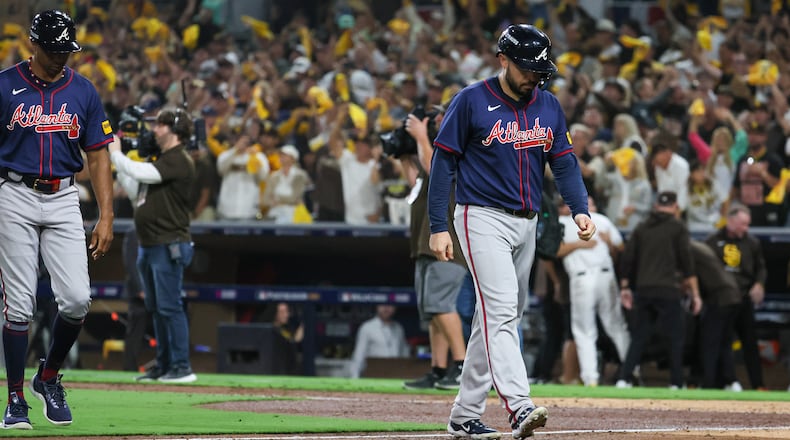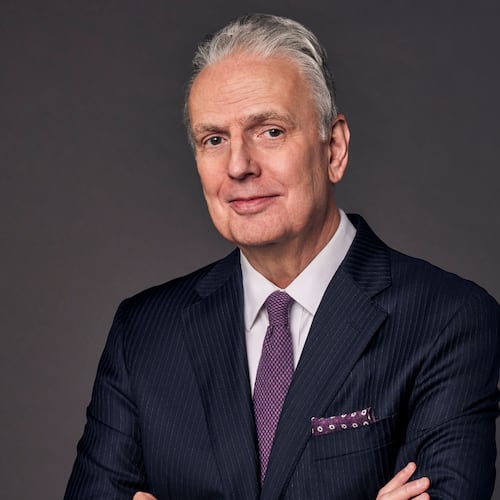Maybe they’re still paying off the debt accrued at MLB’s Bank of Karma. The worst playoff qualifier of 2021 – record-wise, the worst Braves team of the past seven years – went 11-5 in the postseason and became world champs. Since then, the Braves are 2-8 in playoff games.
Maybe that explains how the Braves, who sacrificed Vaughn Grissom for the express purpose of having Chris Sale in October, saw Sale – who’s about to win his first Cy Young award – rendered unavailable Sept. 30. To their credit, the Braves won Monday’s Game 2 to make the playoffs. Now the corresponding debit: In the brief Round 1, their starting pitchers’ ERA was 21.60.
In the chill light of sudden hindsight, it’s easy – and not altogether incorrect – to suggest this never was going to be the Braves’ year. Spencer Strider and Ronald Acuna were lost in April. Austin Riley and A.J. Minter were gone by September. Michael Harris, Ozzie Albies and Sean Murphy missed months. Max Fried and Reynaldo Lopez missed weeks. That’s most of a lineup and a rotation right there. And yet …
As late as Sept. 29, the Braves had enough pitching and just enough hitting to make some of us – I’m among that number – believe they could catch another autumn wave. They led the majors in ERA. Even in their weakened state, they finished fourth in home runs. Pitching and power can carry a team deep into October. These Braves never had a chance.
Much of that is due to scheduling. Much, though not quite all. The Braves lost enough September games to lesser lights – two to Cincinnati, one to Colorado, Toronto and Miami – that they entered the final week needing to catch somebody. Two rainouts forced a doubleheader, the opener of which saw the Braves blow leads in the eighth and ninth. That meant Sale, saved for elimination games, was needed. He was a no-go. Back spasms.
Minus the NL’s presumptive Cy, the Braves turned to the journeyman Grant Holmes. He worked four scoreless innings and left with a lead. At last, the Braves claimed their wild card. Their reward was to fly cross-country to play Tuesday against the National League’s hottest team. That would have been tough under any circumstances. Making it tougher was that the Braves had nobody to start Game 1.
Sale had a bad back. Lopez started Saturday and relieved Monday. Fried started Friday, Charlie Morton on Sunday, Spencer Schwellenbach in Monday’s Game 1. Holmes would have been the choice, but he’d worked Monday’s Game 2; he didn’t make the Round 1 roster. Given no good options, Brian Snitker picked AJ Smith-Shawver, worker of 4-1/3 big-league innings in 2024, yielder of three playoff home runs in 2023.
Two batters in, the Padres led 2-0. Game 1 was gone, and we’re seeing again how mighty Game 1 in a best-of-three can be. Over 11 completed wild-card rounds since this format was adopted in 2022, the Game 1 winner has taken every single series. (Game 3 of Mets-Brewers is Thursday night.) Still, though: The Braves had Fried for Game 2.
The Padres loaded the bases in the first. They unloaded them in the second. Fried yielded six consecutive hits. (To be fair, he’d taken a batted ball off his leg. Shades of Greg Maddux in Philly, 1993 NLCS.) The series, such as it was, was gone.
Fried, who at his best was among the sport’s best half-dozen pitchers, is surely gone, too. As a free agent, he’ll want a nine-figure contract. He won’t get it here. Morton turns 41 next month and is out of contract; if he pitches next season, it’ll be elsewhere. At some point next season, the Braves’ rotation stands to be Sale, Strider, Lopez, Schwellenbach and … somebody. On paper, that’ll do.
The prized everyday core remains: Acuna, Albies, Harris, Matt Olson, Riley. The Braves could use another outfielder – and yes, we say this every year. Jarred Kelenic barely played in September. Emergency import Jorge Soler is under contact for two more seasons at $16 million per, but he’s 32 and probably a full-time DH.
Which brings us to the incumbent DH. The Braves have the option to keep Marcell Ozuna – also at $16M – for next year. For much of this season, he was the only hitter who hit. He’ll be 34 next month. The Braves can save $15M by buying him out. Me, I’d stick with him another year, but it’s not my money.
It will be intriguing to see what the Braves do with Murphy and Orlando Arcia, who haven’t done much since being named 2023 All-Stars. Arcia will make $2M each of the next two seasons; it’s probably time to upgrade. Murphy, acquired at the expense of William Contreras, is owed $15M per year through 2028. He batted .193 with an OPS of .636. We ask again: Where would the Braves be without Travis d’Arnaud?
There are no perfect teams – even the finest roster isn’t immune to injury – and even the best teams can fall flat in October. This wasn’t the Braves’ best team, but it would have been no shock had it reached the NLCS. That dream died when Sale’s back got ouchy. Now we’re on to the offseason, which will lead into 2025, which will, dare I say, be ...
World Series or bust?
About the Author
Keep Reading
The Latest
Featured



